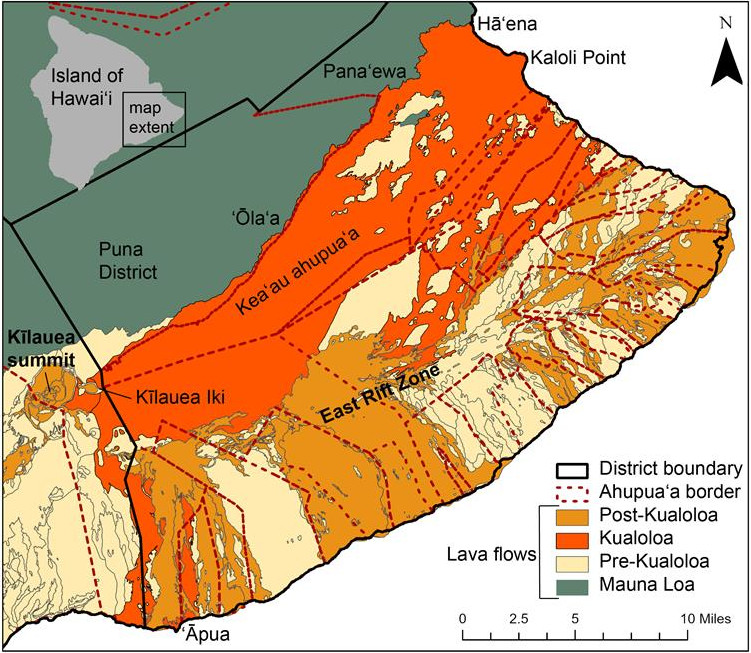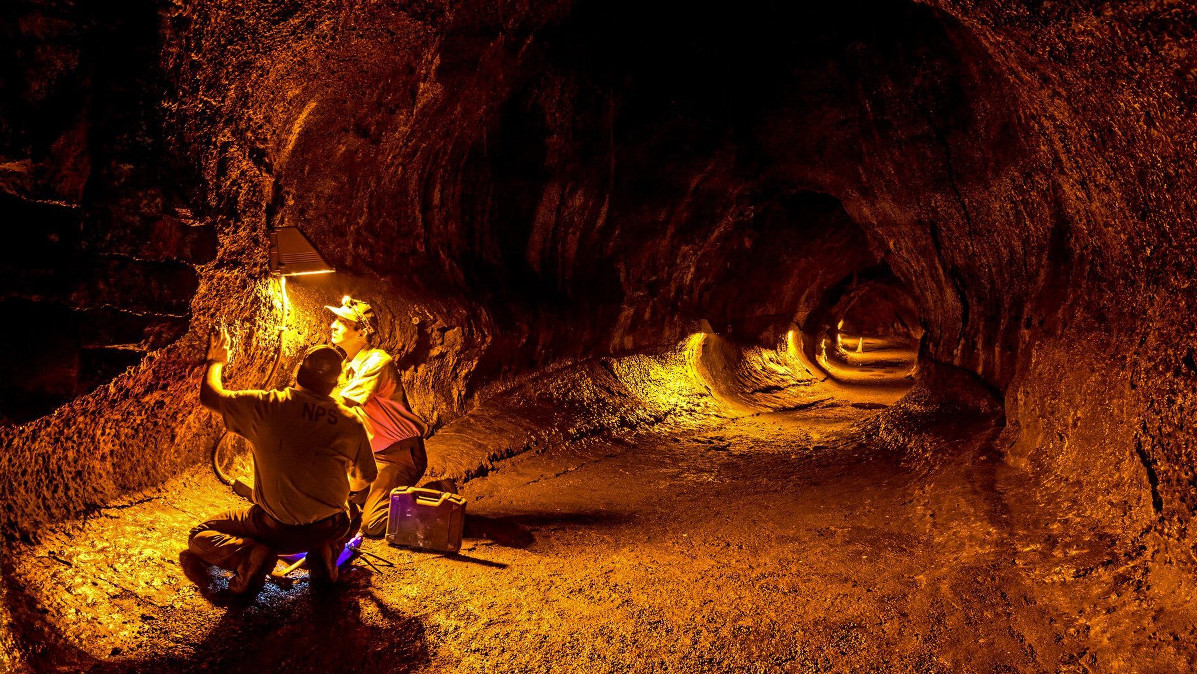(BIVN) – A lava flow that erupted from what is now Kīlauea Iki in the early 1400s – named ʻAilāʻau by a researcher in the 1970s – may have already been named Kualoloa, according to older Native Hawaiian chants.
The name change is the subject of this week’s U.S. Geological Survey Hawaiian Volcano Observatory Volcano Watch article, written by HVO volunteer and naturalist Bobby Camara, with Pualani Kanakaʻole Kanahele and Donald Swanson.
From this week’s article:
Native Hawaiian oral traditions record a rich history of the changing volcanic landscape in Hawaiʻi. Interweaving cultural knowledge with scientific disciplines can provide a more complete understanding of past events, including the largest known lava flow eruption of Kīlauea.
During the 1970s, Robin Holcomb conducted his doctoral field work and research on Kīlauea while working at the USGS Hawaiian Volcano Observatory. His work included mapping a series of lava flows (now called a flow field) that began erupting in the early-1400s from a vent near the eastern end of what is now Kīlauea Iki crater, in the summit region of Kīlauea volcano. Now, we know that the flow field was active for about 60 years and traveled in a northeast direction (as well as a small south branch), covering most of the Puna District north of the East Rift Zone of Kīlauea. Holcomb referred to this flow field as “ʻAilāʻau” after a reference he found in William D. Westerveltʻs “Hawaiian Legends of Volcanoes,” published in 1916.
In ʻŌlelo Hawaiʻi (the Native Hawaiian language), ʻAilāʻau is to “consume trees.” Trees can be consumed by rot, or can topple during windstorms, lightning strikes, floods, and lava flows. ʻAilāʻau is also thought, by some, to have been an elemental force associated with volcanic activity prior to the arrival of Pelehonuamea (Pele of the reddish earth) in the Hawaiian Islands.

USGS: “Map showing Kualoloa lava flows originating near the summit of Kīlauea, with pre- and post-Kualoloa lava flows shown for context. District boundaries and ahupuaʻa borders are also shown, along with placenames mentioned in text. The broader northeastern trending part of the Kualoloa flow field contains a number of kīpuka, and a lava delta was built, creating ka lae Kaloli, the prominent point at the shore. Kaloli is the approximate terminus of a 40-mile-long system of lava tubes that enabled the far and wide distribution of pele during the prolonged eruption. The much smaller south branch of the Kualoloa flows that went towards ʻĀpua is now partially buried by the early 1970s Maunaulu flows.”
Holcomb noted that his choice of ‘Ailā‘au as a name was provisional given that he only found it in one reference, and he was under a publication deadline. Hawaiian language sources during the last 40 years have rapidly become more available. Recently, researchers have been reminded of “Kualoloa,” a chant that accurately describes the emplacement of the flow field that Holcomb named ‘Ailā‘au.
The chant “Kua loloa,” published in 1915 by Nathaniel Emerson in “Pele and Hiiaka, A Myth From Hawaii,” describes an eruption that began in the upland (ma uka) portions of the ahupuaʻa (Native Hawaiian land division) of Keaʻau. The chant describes a broad geographic area affected by the eruption. The forests of Panaʻewa and ʻŌlaʻa were destroyed, with “a blanket of smoke” covering Puna all the way to ʻĀpua.
Much of the District was devastated, according to the chant, which documents Pele destroying forests belonging to her sister, Hiʻiaka, as a result of a serious misunderstanding between them. Examining familiar place names in the chant, compared to the geographic extent of the flow field mapped by Holcomb, suggests that the chant chronicles the lava flows that he had named ‘Ailā‘au. However, there is no mention of ‘Ailā‘au in the Kualoloa chant.
The upland border of Keaʻau ahupuaʻa, where the Kualoloa chant notes the eruption began, is near the eastern end of Kīlauea Iki, where the mapped vent of the lava flows is located. The chant describes Pele moving northeast into Puna, through ʻŌlaʻa and Panaʻewa, following the mapped lava flow paths. A relatively small flow moved southward from the vent to ʻĀpua, just as the chant implies.
A modern understanding of the timing of this eruption and its geographic extent, as well as more detailed knowledge of Native Hawaiian traditional place names, allows us to correlate the 15th-century eruption to the Kualoloa chant. This is an example illustrating the complex relationship between Native Hawaiian oral traditions and specific volcanic events and lava flows as documented in the geologic record.
Native Hawaiian oral traditions and scientific papers have different intended audiences and use their own vocabularies. Events described in chants are not “time-stamped,” but careful study of them, together with knowledge of place names, and clues from scientific evidence of natural phenomena, sometimes allow us to construct correlations between seemingly disparate sources of knowledge. What Holcomb had provisionally referred to as the ʻAilāʻau flow field, we now know should be labeled in future publications the Kualoloa flow field.


by Big Island Video News7:54 am
on at
STORY SUMMARY
PUNA, Hawaiʻi - An examination of Hawaiian oral traditions leads to a consideration of whether Kualoloa would be a more appropriate name for the ʻAilāʻau lava flow field.